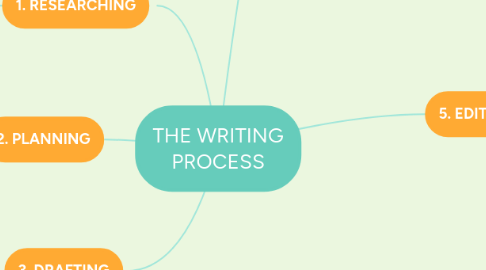
1. 1. RESEARCHING
1.1. Find out about the nature of the assignment and what audience expect.
1.2. Determine the exact kind of research you must do.
2. 2. PLANNING
2.1. Clustering
2.2. Brain storming
2.2.1. Don’t stop to delete, rearrange, or rewrite anything
2.2.2. Don’t worry about spelling, punctuation, grammar, etc.
2.2.3. Keep the ideas flowing
2.2.4. After few minutes, add and delete some ideas or combine or rearrange
2.3. Outlining
3. 3. DRAFTING
3.1. Write the easiest part first
3.2. Write straight through
3.3. Allow enough time to evaluate
3.4. Get frequent outside opinions
3.5. Start considering what best to enhance the quality of the work
4. 4. REVISING
4.1. Allow enough time to revise
4.1.1. Avoid drafting and revising in one sitting
4.1.2. Ask a co-worker, friend, or family to comment
4.1.3. Plan to read the revised work more than once
5. 5. EDITING
5.1. Sentences
5.1.1. - Don’t use too long/too short sentences - Don’t use complex sentences - Use clear sentences
5.1.1.1. Avoid needlessly complex or lengthy sentence
5.1.1.2. Combine short, choppy sentence
5.1.1.3. Tell who does what to whom or what
5.1.1.4. use strong, active verbs
5.1.1.5. Avoiding piling modifiers in front of nouns
5.1.1.6. Beggin with the same subject or ending with an object
5.1.1.7. Replace phrases or clauses with one or two word synonyms
5.2. Words choices
5.2.1. Cutting out unnecessary word
5.2.2. Eleminating sexist language
5.2.2.1. Replace sexist words with neutral ones
5.2.2.2. Watch masculine pronouns
5.2.2.2.1. Make subject as plural or neutral
5.2.2.2.2. Replace pronoun his with ‘the’ or ‘a’
5.2.2.2.3. Use his or her instead of his
5.2.2.2.4. Reword the sentences using passive voice
5.2.2.3. Eliminate sexist salutations
5.2.2.4. Avoid words ending in a diminutive
5.2.2.5. Never single out a person’s physical appearance
5.2.3. Avoid stereotypical language
5.2.3.1. race, nation, origin, or sexual orientation
5.2.3.2. Age
5.2.3.3. Disability
